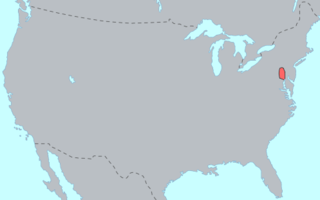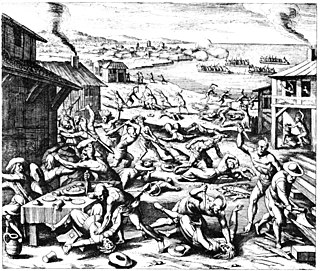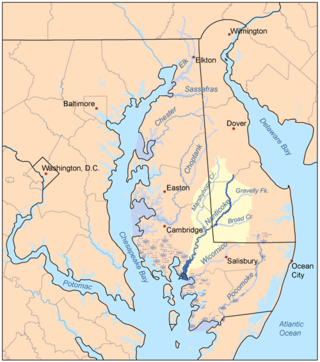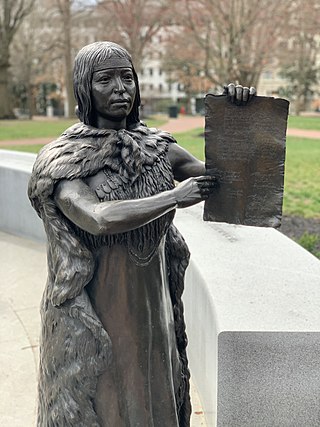Related Research Articles

Among the Haudenosaunee the Great Law of Peace, also known as Gayanashagowa, is the oral constitution of the Iroquois Confederacy. The law was written on wampum belts, conceived by Dekanawidah, known as the Great Peacemaker, and his spokesman Hiawatha. The original five member nations ratified this constitution near modern-day Victor, New York, with the sixth nation being added in 1722.
The Covenant Chain was a series of alliances and treaties developed during the seventeenth century, primarily between the Iroquois Confederacy (Haudenosaunee) and the British colonies of North America, with other Native American tribes added. First developed in the New York area at a time of violence and social instability for the colonies and Native Americans, the English and Iroquois councils and subsequent treaties were based on supporting peace and stability to preserve trade. They addressed issues of colonial settlement, and tried to suppress violence between the colonists and Indian tribes, as well as among the tribes, from New England to the Colony of Virginia.

The Susquehannock, also known as the Conestoga, were an Iroquoian people who lived in the Susquehanna River watershed in what is now Pennsylvania. Their name means “people of the muddy river.”

The Indian Massacre of 1622 took place in the English Colony of Virginia, British America in the present-day United States, on March 22, 1622. The explorer John Smith, though he was not an eyewitness, wrote in his History of Virginia that warriors of the Powhatan "came unarmed into our houses with deer, turkeys, fish, fruits, and other provisions to sell us". The Powhatan then grabbed any tools or weapons available and killed all the English settlers they found, including men, women, and children of all ages. Opechancanough, chief of the Powhatan Confederacy, led a coordinated series of surprise attacks, and they killed a total of 347 people, a quarter of the population of the Colony of Virginia in the massacre.

The Nanticoke people are a Native American Algonquian people, whose traditional homelands are in Chesapeake Bay and Delaware. Today they live in the Northeastern United States and Canada, especially Delaware; in Ontario; and in Oklahoma.

The Pamunkey Indian Tribe is one of 11 Virginia Indian tribal governments recognized by the Commonwealth of Virginia, and the state's first federally recognized tribe, receiving its status in January 2016. Six other Virginia tribal governments, the Chickahominy, the Eastern Chickahominy, the Upper Mattaponi, the Rappahannock, the Monacan, and the Nansemond, were similarly recognized through the passage of the Thomasina E. Jordan Indian Tribes of Virginia Federal Recognition Act of 2017 on January 12, 2018. The historical people were part of the Powhatan paramountcy, made up of Algonquian-speaking nations. The Powhatan paramount chiefdom was made up of over 30 nations, estimated to total about 10,000–15,000 people at the time the English arrived in 1607. The Pamunkey nation made up about one-tenth to one-fifteenth of the total, as they numbered about 1,000 persons in 1607.

The Piscataway Indian Nation, also called Piscatawa, is a state-recognized tribe in Maryland that is descended from the historic Piscataway people. At the time of European encounter, the Piscataway was one of the most populous and powerful Native polities of the Chesapeake Bay region, with a territory on the north side of the Potomac River. By the early seventeenth century, the Piscataway had come to exercise hegemony over other Algonquian-speaking Native American groups on the north bank of the river. The Piscataway nation declined dramatically before the nineteenth century, under the influence of colonization, infectious disease, and intertribal and colonial warfare.

The Piscataway or Piscatawa, are Native Americans. They spoke Algonquian Piscataway, a dialect of Nanticoke. One of their neighboring tribes, with whom they merged after a massive decline of population following two centuries of interactions with European settlers, called them the Conoy.

Cockacoeske was a 17th-century leader of the Pamunkey tribe in what is now the U.S. state of Virginia. During her thirty-year reign, she worked with the English colony of Virginia, trying to recapture the former power of past paramount chiefs and maintain peaceful unity among the several tribes under her leadership. She was the first of the tribal leaders to sign the Virginia-Indian Treaty of Middle Plantation. In 2004 Cockacoeske was honored as one of the Library of Virginia's "Virginia Women in History".
The Treaty of Tehuacana Creek was signed at Tehuacana Creek on October 9, 1844 between representatives from the Republic of Texas and various Native American tribes. The tribes involved in the signing of the treaty were the Comanche, the Keechi, the Waco, Caddo, Anadarko, Ioni, Delaware, Shawnee, Cherokee, Lipan Apache, and Tawakoni tribes. Based on the terms of the treaty, both Native Americans and Texans agreed to cease all hostilities and establish more cooperative political and commercial ties.

The Lodge Reservations, written by United States Senator Henry Cabot Lodge, the Republican Majority Leader and Chairman of the Committee on Foreign Relations, were fourteen reservations to the Treaty of Versailles and other proposed post-war agreements. The Treaty called for the creation of a League of Nations in which the promise of mutual security would hopefully prevent another major world war; the League charter, primarily written by President Woodrow Wilson, let the League set the terms for war and peace. If the League called for military action, all members would have to join in.

The Lachine massacre, part of the Beaver Wars, occurred when 1,500 Mohawk warriors launched a surprise attack against the small settlement of Lachine, New France, at the upper end of Montreal Island, on the morning of 5 August 1689.

The Doeg were a Native American people who lived in Virginia. They spoke an Algonquian language and may have been a branch of the Nanticoke tribe, historically based on the Eastern Shore of Maryland. The Nanticoke considered the Algonquian Lenape as "grandfathers". The Doeg are known for a raid in July 1675 that contributed to colonists' uprising in Bacon's Rebellion.

Native American civil rights are the civil rights of Native Americans in the United States. Native Americans are citizens of their respective Native nations as well as the United States, and those nations are characterized under United States law as "domestic dependent nations", a special relationship that creates a tension between rights retained via tribal sovereignty and rights that individual Natives have as U.S. citizens. This status creates tension today, but was far more extreme before Native people were uniformly granted U.S. citizenship in 1924. Assorted laws and policies of the United States government, some tracing to the pre-Revolutionary colonial period, denied basic human rights—particularly in the areas of cultural expression and travel—to indigenous people.
The Treaty of Bird's Fort, or Bird's Fort Treaty was a peace treaty between the Republic of Texas and some of the Indian tribes of Texas and Oklahoma, signed on September 29, 1843. The treaty was intended to end years of hostilities and warfare between the Native Americans and the white settlers in Texas. The full title of the treaty was "Republic of Texas Treaty with the Indigenous Nations of the Delaware, Chickasaw, Waco, Tawakani, Keechi, Caddo, Anadahkah, Ionie, Biloxi, and Cherokee." The principal negotiators for the Republic of Texas were Edward H. Tarrant and George W. Terrell.
The Assateague were an Algonquian people speaking the Nanticoke language who historically lived on the Atlantic coast side of the Delmarva Peninsula.

The history of Native Americans in Baltimore and what is now Baltimore dates back at least 12,000 years. As of 2014, Baltimore is home to a small Native American population, centered in East Baltimore. The majority of Native Americans now living in Baltimore belong to the Lumbee, Piscataway, and Cherokee nations. The Piscataway people are indigenous to Southern Maryland, living in the area for centuries prior to European colonization, and are recognized as a tribe by the state of Maryland. The Lumbee and Cherokee are indigenous to North Carolina and neighboring states of the Southeastern United States. Many of the Lumbee and Cherokee migrated to Baltimore during the mid-20th century along with other migrants from the Southern United States, such as African-Americans and white Appalachians.

The land that is now the State of Maryland in the United States of America was widely populated by indigenous peoples prior to European arrival, however only 2% of the state's population self-reported as being some part Native American in the 2020 US census. Native Americans have inhabited the area since c. 10,000 BC, with Capt. John Smith surveying and making contact with groups in the Chesapeake Bay in the early 1600s. European settlers first began to inhabit Maryland in 1634, but as the century progressed, violence and hostility between Native Americans and European settlers increased. Various treaties and reservations were established in 1600s and 1700s, but many Native peoples left the area in the mid-to-late 18th century. Today, there are Native American populations around the state, including a sizable Lumbee population in Baltimore.
The Piscataway Conoy Tribe of Maryland is a Native American tribe recognized by the state of Maryland. They are a part of the Piscataway people.
References
- ↑ "Proceedings and Acts of the General Assembly, April 1666-June 1676". Maryland State Archives . Retrieved 2021-04-28.
- ↑ "D.C. Council votes to rename Lafayette rec center and park, honor long-ignored Indian treaty" . Retrieved 2021-04-28.